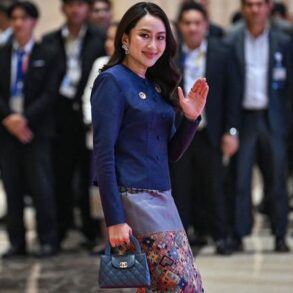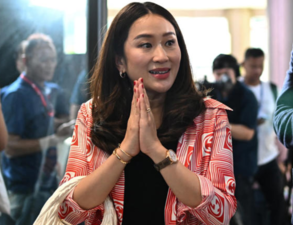PARIS – Since opening in March 2022, La Galerie Dior at the brand’s historic flagship in Paris has drawn 650,000 visitors with its rotating exhibitions dedicated to its fashion archives. Now, for the first time, the space is celebrating the house’s collaborations with female artists.
Its new show, set to open on Friday and run through May 13, features works ranging from a Leonor Fini painting from the 1930s originally exhibited by founder Christian Dior during his early career as a gallerist, to a 1967 “Nana” sculpture by Niki de Saint Phalle that illustrates her longstanding friendship with Marc Bohan during his stint as creative director.
These historic pieces sit alongside more recent and specially commissioned works by contemporary artists including Judy Chicago, Eva Jospin, Brigitte Niedermair, Katerina Jebb and Elina Chauvet, among others.
“The gallery aims to be a laboratory of sorts in terms of what we can show here and how it can cast the history of the house in a fresh light,” Olivier Flaviano, head of La Galerie Dior, told WWD during a preview visit.
“This new exhibition aims to show that fashion is an object, but can also become a subject by virtue of the messages it carries. The diverse visions of Dior through the gaze of female artists will carry those different messages,” he added.
Dior strongly believed in elective affinities, surrounding himself with musicians, writers and painters that influenced his work. Likewise, Maria Grazia Chiuri, artistic director of womenswear since 2017, has brought on board a succession of artists to amplify her feminist messaging.
Near the entrance is Niedermair’s photo of the T-shirt bearing the slogan “We Should All Be Feminists” that Chiuri showed as part of her debut collection.

Works by Elina Chauvet.
Adrien Dirand /Courtesy of Dior
An entire room is dedicated to Chauvet, the Mexican artist who collaborated with the designer on a sequence of dresses featured in the finale of her cruise collection shown in Mexico City in May. Made of white cotton muslin embroidered with red thread, they carry messages designed to raise awareness of violence against women.
“My whole work is feminist,” Chauvet explained in an interview. Her “Red Shoes” installations, featuring dozens of pairs of red shoes set up in public squares around the world in memory of those who have been killed, have traveled to 27 countries, but she credited Chiuri with further broadening her reach.
“Something very magical happened with Maria Grazia. It was as if we shared the same energy or synchronicity, so it was a joint effort,” she added.
Working with a group of female embroiderers in Mexico, Chauvet created a fresh set of items for the exhibition, including toile versions of vintage Dior jacket designs bearing messages such as “Mi derecho es decidir” (“It’s my right to choose”) or “Ni soy de tu propiedad” (“I am not your property.”) They are shown alongside portraits by Maya Goded.
“At first I was intimidated to think, what will I make of these? But Maria Grazia and the Dior teams gave me complete freedom, which really encouraged me,” she recalled. “The room with the clothes is spectacular. It’s magnificent. I’m deeply moved by how they chose to show my work.”
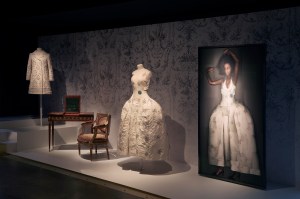
A Dior design by Raf Simons alongside a work by Katerina Jebb.
Adrien Dirand /Courtesy of Dior
Jebb has collaborated with Dior since 2018 on various projects, but doesn’t identify as a feminist artist. “I don’t believe in gender art, actually, so I’m not a good disciple of this movement,” she explained. “I think it’s just about emotion.”
The British artist’s digital artworks, which are made by assembling dozens of scanned images, are featured in various rooms throughout the exhibition.
There is her take on Dior’s iconic Bar jacket, in a room exploring different facets of the couturier’s 10 years at the helm of the house, and her depictions of designs by the brand’s subsequent artistic directors: Yves Saint Laurent, Bohan, Gianfranco Ferré, John Galliano, Raf Simons and Chiuri.
“I try not to make a difference between Napoleon’s coat or Marie Antoinette’s corset and a Dior couture dress from 1947,” she says of her approach to clothing. “It’s a shrine to elegance and the past, and we try to recapture that Proustian thing, but it’s very fragile.”
Among her most striking contributions is an image of Dior’s well-used chair, which hangs by the historic staircase leading to the room that was his office from 1946 to circa 1952.
“I don’t think it’s particularly flattering, but I think it’s truthful,” Jebb said. “It almost is bulging and sort of ungainly, and I think that’s a purposeful gesture by me to say that all is not perfect.”
She was referring to the fact that Dior died at the age of 52, at the height of his powers, but also to the glamor projected by traditional fashion photography.
“I try my best not to make fashion images because that worries me. I would like it to go into another realm if I can, if I’ve succeeded in making the work a little bit strange and not commercial,” she said. “The reflection to take away with this is the time engaged. The time invested in making those clothes is weeks, and then the time invested in me making those artworks is months.”
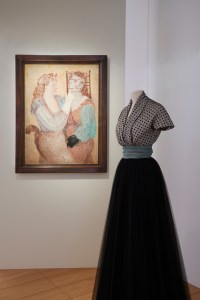
Christian Dior’s Colette dress alongside a Leonor Fini painting.
Adrien Dirand /Courtesy of Dior
Dior has acquired many of the works on show to bolster its archive and demonstrate its commitment to the artists that have collaborated with the house.
“We want to support these artists and give them visibility,” said Flaviano. “Supporting an artist means not only commissioning their works, but also acquiring them in order to potentially show them in another exhibition in future.”
The ballroom-style space features embroidered banners designed by Chicago for Chiuri’s spring 2020 haute couture show, while the cabinet of curiosities showcases Lady Dior handbags customized by the likes of Mickalene Thomas and Joana Vasconcelos as part of the annual Dior Lady Art project.
The room dedicated to Saint Phalle spotlights a lesser-known facet of the house’s history. It juxtaposes three Chiuri outfits from 2018 referencing the French artist’s work with three custom designs by Bohan, who was a collector of Saint Phalle’s work.
Among his creations is the black velvet jumpsuit that she wore in her experimental film “Daddy,” which shows her shooting at aerosol paint cans with a rifle. “You can still see small traces of red paint,” Flaviano pointed out.
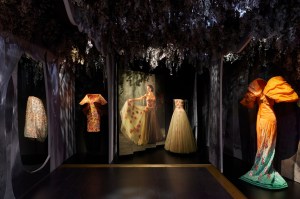
A photograph by Yuriko Takagi alongside Dior designs.
Adrien Dirand /Courtesy of Dior
Other highlights include Japanese photographer Yuriko Takagi’s lifesize photographs of dancers in motion wearing vintage Dior designs, each split into three panels and displayed alongside the corresponding outfits.
“Dior said that for a dress to be successful, you have to have an idea of how it will move in real life, and these photos by Yuriko Takagi really convey that, in addition to possessing a strong poetic charge,” Flaviano enthused.
A key takeaway from the exhibition is that women have played a key role in the house of Dior since its inception. The designer was strongly influenced by his mother Madeleine and his sister Catherine, a French Resistance fighter and concentration camp survivor for whom he created the Miss Dior fragrance.
A photo from 1949 shows Dior posing on a staircase surrounded by members of his team.
“It illustrates to what extent Monsieur Dior was surrounded by women,” said Flaviano. “It also harks back to this idea that is dear to Maria Grazia that the work of this house is a collective effort.”
This post was originally published on this site be sure to check out more of their content.




